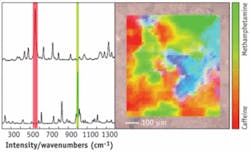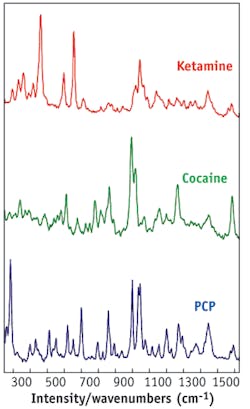Raman spectroscopy helps law enforcement take a bite out of crime
RICK COX, BRYAN RAY, and KEITH CARRON
In the last few years, television drama has launched forensic sciences into the mainstream. Terms such as gas chromatography mass spectrometry, nuclear magnetic resonance, infrared imaging, and fluorescence spectroscopy have become recognizable as techniques used to identify chemicals, narcotics, explosives, fibers, residues, and other materials associated with criminal activity. In line with this trend, Raman spectroscopy—a well-established technique for nondestructive identification of materials in both the lab and the field—has become one of the most popular nondestructive material-identification methods in forensic science.
Raman spectroscopy has come a long way since 1928, when C.V. Raman discovered that a small fraction of wavelengths differed from the incident beam and that these shifts were unique to the molecular structure of the materials measured. Raman is now well understood, and, has become an ideal method for rapidly identifying minerals, organics, plastics, cyanide, and substances dissolved in water. A fundamental advantage of Raman spectroscopy is sampling. Materials can be analyzed through glass and plastic containers, thereby simplifying the analysis of liquids and powders.
Raman and infrared are complementary methods. The difference in energy of the incident and scattered radiation for Raman corresponds to the wavelengths in the infrared. A molecule can have distinguishable equivalent Raman and infrared features. A material is infrared- or Raman-active if there is a change in a molecule’s dipole moment or a change in polarizability during its vibration, respectively. In general, symmetric vibrational modes tend to yield intense Raman lines, and nonsymmetric vibrational modes are inherently weak. Symmetric vibrations such as the C=C, S–S, and ring breathing modes are strong in Raman and forbidden or weak in infrared.
Examining evidence, in and out of the lab
The recent surge of activity using Raman for identifying unknown specimens in the forensic sciences is attributed to the telecommunications and digital technologic booms in the 1990s. As early as the late 1980s, Raman spectrometers were the size of a conventional oven, and the detectors were cryogenically cooled. The miniature spectrometer benefited from the rapid development in photonic components that were used for launching signals over long distances. Furthermore, telecommunication platforms required that the devices operate reliably under a wide range of temperature, humidity, and vibrational activity. Although the telecommunications boom was short-lived, it fueled the development of a wide variety of laser diode modules, semiconductor tunable lasers, gratings, tunable filters, and detectors, which drove down the cost and size of the basic optical elements and enhanced the performance of the miniature spectrometer. The reduction in size of the device allowed seamless integration with the light microscope and provided a platform for portable applications.
One of Raman spectroscopy’s key attributes is its ability to interface with the modern light microscope. Combined visual and spectroscopic identification of an object is very powerful when used to identify unknown substances. In many cases, visual inspection of evidence is inconclusive. Size, shape, and color do not provide conclusive identification of a specimen, whereas a unique Raman signature of an unknown sample can provide identification with a high level of certainty. The microscope assists in targeting the laser on a micron-size object, and diffraction law empowers micro-Raman systems with very small sampling spot sizes when compared to infrared microscopy. For Raman, laser spot sizes on the order of 0.5 to 1 μm can be obtained when using visible laser excitation with high numerical aperture collection optics. A micron-size area of interrogation is useful for measuring defects and fatigue in materials, residual particles on surfaces, microfibers, and high-resolution chemical imaging.
A chemical image provides a distribution map of a component within a defined area of a specimen. The power of chemical imaging is realized by isolating spectrally resolved information collected over a grid of a sample. The data are typically composed of a series of x and y coordinates and a wavelength component. Raman lines of the species of interest are selected, and a hypercube is visually and mathematically treated as a series of spectrally resolved images. An image plane is commonly plotted as a function of a single wavelength, multiple wavelengths, or referenced/normalized wavelengths.
As an example, methamphetamine was dosed in nearly equal proportion to Nodoz cutting agent (see Fig. 1). The Nodoz is nearly 60% caffeine, with the remainder excipient. A chemical image was obtained in 25 μm steps of a 750 × 750 μm area. The chemical image inset highlights the distribution of methamphetamine in the sample. The green and red areas represent methamphetamine and caffeine, respectively, and other colors correspond to the excipient from the Nodoz cutting agent.
Mobile Raman
The motivation for advancing Raman spectroscopy from the laboratory to the field is that straightforward identification of samples in the field minimizes sample backlog in the laboratory, delineates multiple crime-scene samples, allows presumptive testing for early arrest of suspects, and provides rapid feedback for first responders. In early 2000, Raman spectrometers were scaled to the miniature spectrometer for handheld applications, with assistance from the telecommunications industry. As described earlier, the advancement of optical components for powerful excitation sources (laser diodes) and optical scanners (CCDs) had a dramatic influence on compact Raman systems. This particularly influenced handheld devices which have a much smaller form factor than laboratory systems. Proprietary packaging technology incorporates 785 and 808 nm laser diodes into portable systems without sacrificing power or performance characteristics. Laser diodes incorporate feedback components and thermoelectric control that provide narrow linewidth and single-mode laser excitation in a miniature TO package. Furthermore, simple thermoelectric modification on CCDs provides cooling. Lightweight and high-capacity lithium batteries further assisted in powering the unit. Many of these systems operate three to five hours without recharge.
The size and form factor for Raman spectrometers are rapidly changing. The system developed by DeltaNu in 2001 weighed 4.5 lb, which was considered rather small for its time. A most recent development has produced a palm-size form factor that weighs a mere 11 oz. Law- enforcement personnel can use this device for roadside presumptive drug testing. Illicit narcotics are displayed on a screen to alert the officer to the identity of the suspect sample.
Most law enforcement personnel are not trained in Raman spectroscopy, but the technology can be packaged into a black-box format. The layman analyzes an ASTM standard to validate that the device is functioning properly. Once the device is properly validated, an unknown sample is analyzed by comparing its Raman spectrum to those of materials that have been previously characterized and stored in a library. Matching algorithms are used to provide a correlation match of the unknown with the materials stored in the library (see Fig. 2). A match of the sample is shown on the screen for the officer to determine if the unknown material is an illegal substance.The miniature spectrometer is the building block for fabricating compact and portable Raman systems. A demonstration of the mainstream use of this technology is the detection and characterization of narcotics for law enforcement. A chemical image obtained from a Raman microscope can provide the distribution of methamphetamine and Nodoz cutting agents in a sample. The chemical image plots are useful for the layman (juror, judge, or attorney) to interpret evidence analyzed by the lab. A palm-size Raman device gives law-enforcement officers a rapid and nondestructive narcotic-detection system for roadside application.
Rick Cox is director of business development, Bryan Ray is applications scientist, and Keith Carron is managing director at DeltaNu 628 Plaza Lane, Laramie, WY 82070. Contact Cox at [email protected].

